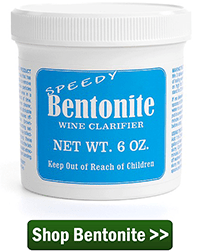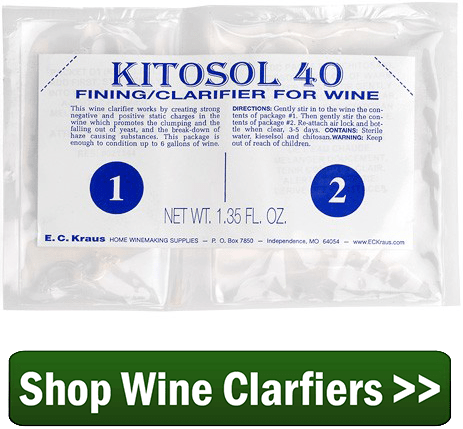 I’ve been reading about bentonite fining in my wine and would like to know what is the downside of using this stuff? I understand what it does, but was thinking – if there is no downside then I should use it in every wine I make. What is your response to that, please!
I’ve been reading about bentonite fining in my wine and would like to know what is the downside of using this stuff? I understand what it does, but was thinking – if there is no downside then I should use it in every wine I make. What is your response to that, please!
Steven
_____
Hello Steven,
Commercial wineries routinely make bentonite fining additions to the wine right after the fermentation. It is used at this time because it is effective in taking out large amounts of solids fairly quickly. It speeds up the clearing process.
Bentonite additions to a wine will not only take the bulk of the yeast out, but it will also take out other protein based particles such as tannin, color pigmentation and other pulp-related materials. So much so, that one might say it is too good.
For this reason one must be careful not to use more bentonite fining than is necessary to get the job done. Using too much bentonite in the wine can result in a decrease in body, color and overall character of the wine. This is the potential downside.
can result in a decrease in body, color and overall character of the wine. This is the potential downside.
Fortunately, bentonite fining is efficient enough that it will do the job before threatening dosages come into play. Follow recommended dosages and you will have not have a problem. And yes, we recommend using it on any fresh fruit wine.
The bentonite fining we sell comes with detailed directions and a recommended dosage that is considered conservative. If these directions are followed and the recommended dosage is adhered to, your wine will not be negatively affected in any way.
While bentonite is effective in removing a lot of particles quickly, there are times when it will not remove the last little bit that is required to bring a polish to your wine. If you discover that a single bentonite fining addition was unable to add a bright color to the wine, then I would suggest that you go to another fining agent for a second treatment.
 Wineries will turn towards fining agents that have more polishing qualities as a follow-up treatment. These would include fining agents such as Sparkolloid, isinglass and Kitosol 40.
Wineries will turn towards fining agents that have more polishing qualities as a follow-up treatment. These would include fining agents such as Sparkolloid, isinglass and Kitosol 40.
So in short, yes it’s not a bad idea to automatically make bentonite addition to your wines right after fermentation. There is little to no downside in doing so. Just be aware that it is so effective that there are limitations to how much you’ll want to use. Stick to the recommended dosages and your wine will be fine.
Happy Wine Making!

Why do all wine Kits have you add the bentonite at the beginning before you add the juice and yeast?
Russell, adding bentonite prior to beginning fermentation helps aid the yeast in growing quicker and stronger. It also helps to settle out the dead yeast cells so that you are not transferring a lot of sediment into your secondary fermentor after racking.
Hello Friends,
I have question re adding bentonite prior to fermentation. After making new bath with fruits, sugar and water I add Camden and pectic enzyme. After 24 hrs the bath is ready for adding yeast. When in this process I need to add bento slurry?
Thanks.
Walter, when adding bentonite prior to fermentation to help invigorate the yeast, you want to add small amounts. All you need for 5-gallons of wine is about 4 teaspoons as opposed to the 1-2 tablespoons per gallon you will add after fermentation. The article posted below will discuss this in more detail.
Clarifiers Before Fermentation
http://blog.eckraus.com/wine-clarifiers-before-fermentation
Can the yeast/bentonite mixture that has settled be re-pitched as you would with the yeast that would normally flocculate out over time. It there any need to separate the bentonite from the yeast or can this even be accomplished. I am fermenting mead not wine.
Robert, Actually, we do not recommend using the wine yeast sediment to make additional batches of wine/mead. While the practice of using the left over sediment is sometimes used when making beer, we do not recommend this practice when making wine. Due to the higher alcohol by volume content of wine/mead, reusing the wine yeast sediment can cause the yeast to become stressed therefore causing off flavors in the wine/mead.
I’m a few days into secondary on a batch of the banana berry recipe from a Feb post. Looking ahead to fining, what agent do you recommend to maintain the wonderful color that I have from the blackberry?
Kevin, the kitosol 40 is what we would recommend. It will add polish and brilliance that will make the color appear brighter.